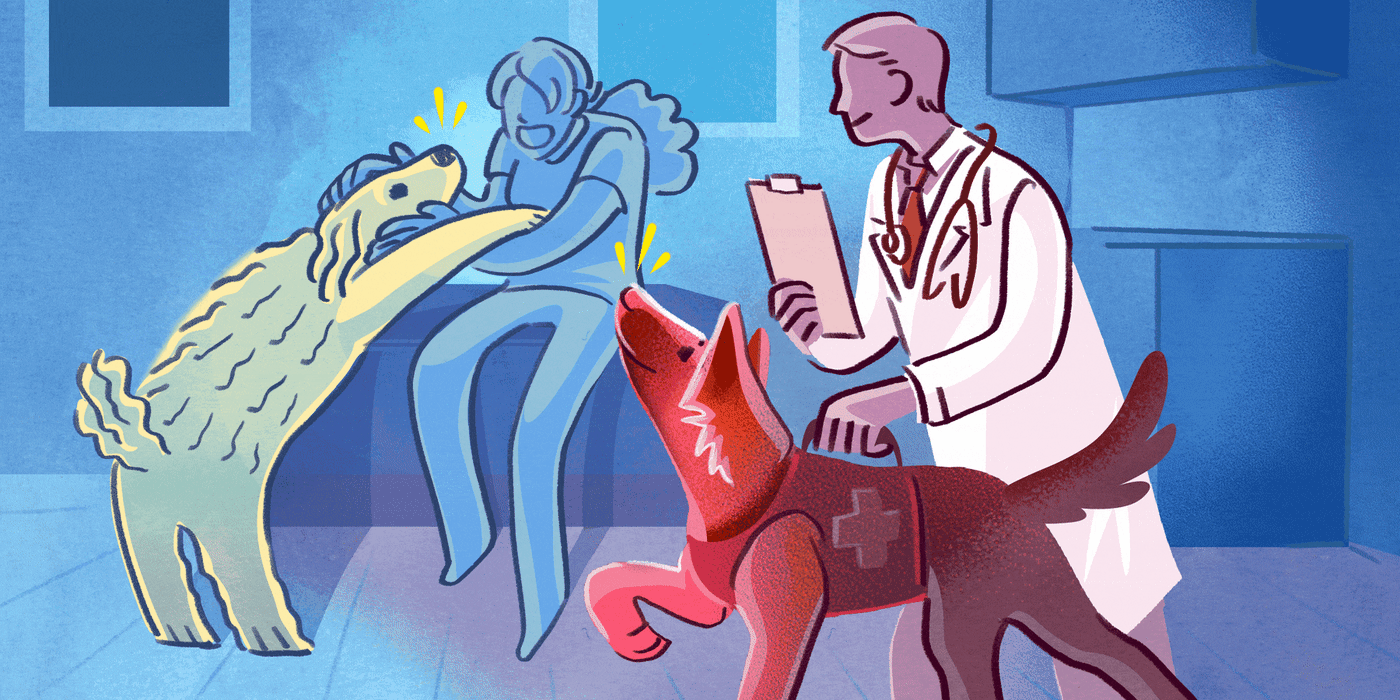As a lifelong, self-proclaimed animal lover, I was delighted to discover the animal-assisted therapy program in our hospital system. The animals, mostly dogs, routinely visit hospitalized patients and their families, and requesting such visits for my patients has become my favorite order. These therapy dogs are so deeply embedded in our hospital that they each have their own profiles and associated trading cards. Like fairy godmothers, the timing of their presence also seems impeccable — a surprise encounter on a challenging day, or an accidental hallway run-in just when rounding fatigue has settled in. One hospital animal in particular, a miniature horse, inspires a frenzy among the residents whenever she’s in sight. During the minutes when we’re marveling and clapping at the horse’s tricks (her piano playing is particularly impressive), we feel a joyous respite from the somber reality of working in a hospital during the pandemic.
My colleagues and I are not alone in benefiting from the presence of hospital animals. For my patients as well, a wagging tail can calm and ease a hospital stay. I vividly recall how one such patient shrieked with delight at the sight of a well-groomed poodle after she had spent over a week in the hospital. Research also supports this: A 2007 study showed that a 12-minute visit from a therapy dog was associated with improved cardiopulmonary hemodynamics, neurohormones, and anxiety in hospitalized adults with heart failure. Even in the critical care setting, animal-assisted therapy has the potential to increase patients’ engagement and motivation in their own care, which is especially promising considering the added risk of delirium, anxiety, and PTSD while hospitalized.
Two years ago, when the COVID-19 pandemic first began, in-person visits from therapy animals were placed on pause. During that time, I was working in the ICU. Among my patients was a 40-year-old woman admitted with acute liver failure who was now undergoing the evaluation process for a liver transplant. Half the pictures decorating her ICU room were of her human family and friends. The other half were of her two cats. By then, she had endured multi-organ failure, resulting in a tracheostomy with mechanical ventilation, continuous renal replacement therapy, and multiple pressors. Although she was sometimes awake and interactive, each day was tenuous. Recurrent pulmonary hemorrhage or any other complication could tip her over the edge before she could get a new liver, and that was only if she ended up qualifying as a transplant candidate.
When I walked into this patient’s room each day, I was also greeted by two stuffed animal cats, standing in for the real cats awaiting her at home. One was black and white, and the other was a classic calico. Perched on her hospital bed, they gently rested underneath a tangle of lines, drips, and other monitoring wires. One morning, I found the stuffed cats wearing surgical masks fashioned from extra supplies. Although my patient could no longer speak, I pointed at her stuffed cats and laughed, complimenting and admiring their compliance with hospital masking policies. She nodded her head and tried to smile. In that moment, it seemed those stuffed animals were a metaphor for my patient’s resilience — much as real animals have been for me and my colleagues during the pandemic.
A month after I finished that ICU service, I learned that my patient had died after her prolonged ICU hospitalization. I thought about those two stuffed cats on her hospital bed, a small reminder of unconditional love and companionship, and I hoped that they were able to offer some comfort to her at the end of her life. This is the promise of animals in the hospital setting: They are a source of joy and help, even for those who will not leave the hospital. I am grateful for all the animals that pass through our doors.
Have you experienced the benefits of animal-assisted therapy? Share your experiences in the comments below.
Evaline Cheng is an internal medicine resident at the University of California, Los Angeles and an aspiring cardiologist who seeks to improve the delivery of cardiovascular care. As a lifelong journal writer, she now shares stories of narrative medicine to connect and project voices otherwise unheard. Dr. Cheng is a 2021–2022 Doximity Op-Med Fellow.
All names and identifying information have been modified to protect patient privacy.
Animation by April Brust







